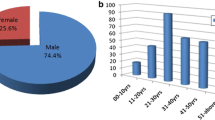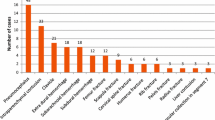Abstract
Background
Maxillofacial fractures occur in a significant proportion worldwide and can occur as an isolated injury or in combination with other severe injuries including cranial, spinal, and upper and lower body injuries requiring prompt diagnosis with possible emergency interventions. The epidemiology of facial fractures varies with regard to injury type, severity, and cause and depends on the population studied. Hence, understanding of these factors can aid in establishing clinical and research priorities for effective treatment and prevention of these injuries.
Materials and methods
In this present retrospective study, we provide a comprehensive overview regarding cranio-maxillofacial trauma on 3611 patients to assist the clinician in assessment and management of this unique highly specialized area of traumatology. A preformed pro forma was used to analyze the medical records of patients treated for facial trauma in The Department of Oral and Maxillofacial Surgery, Meenakshi Ammal Dental College and Hospital, Chennai. The distribution according to age, gender, etiology, type of injury, time interval between accident and treatment, loss of consciousness, facial bones involved, pattern of fracture lines, treatment offered, and postoperative complications were recorded and evaluated.
Results
We inferred male patients sustained more injuries mostly in the third decade of age. Road traffic accidents were the most common cause of injury. Mandible was the most commonly fractured bone in the facial skeleton. Soft tissue injuries occurred more in road traffic accidents and upper lip was the commonest site of injury.
Conclusion
Our study provides insights into the epidemiology of facial injuries and associated factors and can be useful not only in developing prevention strategies but also for grading the existing legal regulations and also for framing a more effective treatment protocol.
Similar content being viewed by others
References
Moosa Z, Alikhaji MK, Mohd R (2004) An epidemiological study of facial injuries during a 13 month of trauma registry in Tehran. Ind. J. of Medical Sciences 58:3
Z Ahmed Rana, N Ahmed Khoso, O Arshad, KM Siddiqui. An assessment of maxillofacial injuries: a 5 year study of 2112 patients. Ann. Pakistan. Inst. Med. Sciences 2012; 6;2; Pgs 113–115
Shahim F N, Cameron P, Neil MC. Maxillofacial trauma in major trauma patients. Aust Dent J 2006. 51;3; 225–230
Emshoff R, Schöning H, Rothler G, Waldhart E (1997) Trends in the incidence and cause of sport-related mandibular fractures: a retrospective analysis. J Oral Maxillofac Surg 55(6):585–592
SW Perkins, SH Dayan, EC Sklarew, M Hamilton, GS Brussel. Incidence of sports related facial trauma in children. Ent Journal2000.
Siida, M. Kogo, T. Suguira, T. Mima, T. Matasuya. Retrospective analysis of 1502 patients with facial fractures IntJOf Oral And Maxillofacial Surgery 2001;30;86–290
Keiser J. Incidence of maxillofacial trauma in Newzealand. Journal of Oral and Maxillofacial Surgery .2002.Aug;32;323–325.
Olasoji H O, Tahir A, Arotiba G T. Changing trends and characteristics of maxillofacial injuries in Nigeria. BrJOral And MaxFacSurgery Volume 40, Issue 2, April 2002, Pages 140–143.
Sarasw ATV (2008) Airway management in maxillofacial trauma: a retrospective review of 127 cases. Ind J Anesth 52:311–316
W Hackl, K Hausberger, R Sailer, H Ulmer, R Gassner. Prevelance of cervical spine injuries in patients with facial trauma. Journal Of Oooo And Endodontology. Vol.92. No.4.October 2001.
A Kyrigidis, G Koloutsos, A Kommata, N Lazarides, K Antoniades. Incidence, aetiology, treatment outcome and complications of maxillofacial fractures. A retrospective study from Northern Greece. Journal Of Cranio-Maxillo Facial Surgery. 2013. (J.Jcms.2012.11.046.) Pages 1–7
Wood E B, Freer T J. Incidence and aetiology of facial injuries resulting from motor vehicle accidents in Queensland for a three year period. Aust Dent J 2001;46;4;284–288
Gassner R, Tuli T, Hachl O, Rudisch A, Ulmer H (2003 Feb) Cranio-maxillofacial trauma: a 10 year review of 9,543 cases with 21,067 injuries. J Craniomaxillofac Surg 31(1):51–61
Gassner R, Tuli T, Hachl O (2004) Craniomaxillofacial trauma in children a review of 3385 cases with 6060 injuries in 10 years. JOral And Maxillofac Surg 62:399–407
Zachariades N, Koumoura F, Konsolaki-Agouridaki E (1990) Facial trauma in women resulting from violence by men. J Oral Maxillofacial Surgery 48:1250–1253
Kotecha S, Scanell J, Monaghan A, Williams R W. A four year retrospective study of 1062 patients presenting with maxillofacial emergencies at a specialist pediatric hospital. Br.J.Of Oral And Maxillofac Surg. 2007. 46; Pgs 293–296.
Shah A, Mushtaq MM, Qureshi ZR (2008) Frequency of mandibular fractures at the angle as a result of maxillofacial trauma. Pakistan Oral & Dental Journal 28(1):29–32
Bormann K.H, Wild S, Gellrich NC, Kokemüller H, Stühmer C, Schmelzeisen R, Schön R. Five-year retrospective study of mandibular fractures in Freiburg, Germany: incidence, etiology, treatment and complications, J Oral Maxillofac Surg 2009; 67:1251–1255
Hussaini, R, Nor GM, Aiidrus SM, Ramli R. Maxillofacial trauma with emphasis on soft tissue injuries in Malaysia. IntJ Of Oral And Maxillofacial Surg. 2007. 36; Pgs 797–801
EG Salentijin, B Van Der Bergh, T Forouzanfar. A ten year analysis of facial fractures. Journal Of Cranio Maxillofacial Surgery. 2013. (J.Jcms2012.11.043) Pages 1–7.
Abbas I, Fayyaz M, Shah I, Khan MA, Hakeema S, Munir N, Bibi A, Abbasi M (2009) Demographic distribution of maxillofacial fractures in Ayub teaching hospital: a 7 year review. J Ayub Medical Coll Abottabad 21:2
Shahim FN, Cameron P, Neil MC (2006) Maxillofacial trauma in major trauma patients. Aust Dent J 51(3):225–230
ZJ Andreas, S Benoif, L Oliver, S Nikola, T Hanna, L Tateyuki. Incidence, aetiology and pattern of mandibular fractures in Central Switzerland. Swiss Med Wkly, May, 2011; 141:W13207
Zargar M, Alikhaji MK, Reza M (2004) An epidemiological study of facial injuries during a 13 month of trauma registry in Tehran. Ind J Of Medical Sciences 58:3
P Gomes, L Augusto, J Ricardo. A 5 year retrospective study of zygomatico-orbital complex fractures and zygomatic arch fractures in Sao Paulo Brazil. J Of Oral And Maxillofac Surg. 2006.64; Pgs 63–67
Al-Qamachi LH, Laverick S, Jones DC (2012) A clinico-demographic analysis of maxillofacial trauma in the elderly. Gerodontology Society 29:147–149
Gerbera B, Ahmad N, Parmarc S (2009) Trends in maxillofacial injuries in women. Br J Oral Maxillofac Surg 47:374–377
F Roccia, F Bianchi, E Za, VA Ttero, GT Anteri, G Ramieri. Characteristics of maxillofacial trauma in females: a retrospective analysis of 367 patients. J Craniomaxillofac Surg (2010) 38, Pgs 314–319.
H E A Ahmed, MA Jaber, SH Abu, M Karas. The pattern of maxillofacial fractures in Sharjah Uae.: a review of 230 cases. J Of Oooo And Endodontology. 2004. 98;2; Pg 166–270.
Nicole M, Eggensperger A. Pediatric craniofacial trauma. J Oral And Maxillofacial Surg. 2008. 66; Pgs 58–64.
P Malara, B Malara, J Drugacz. Characteristics of maxillofacial injuires resulting from road traffic accidents—a 5 year review of case records in Poland. Head And Face Medicine, August 2006.
Petersons principle of oral and maxillofacial surgery. Ii Edition. 2004.
Chandrashekhar BR, Reddy CVK (2008) A five-year retrospective statistical analysis of maxillofacial injuries in patients admitted and treated at two hospitals of Mysore City. Indian J Dent Res 19:304–308
IB Kar, Mahavoi BR. Retrospective analysis of 503 maxillofacial trauma cases in Odisha. Journal Of Maxillofacial Oral Surg. 2012. June 11;(2); Pgs 177–181
G Kostakis, G Gikins, G Rahis. An epidemiological analysis of 1142 maxillofacial fractures and concomitant injuries. Journal Of Oooo And Endodontology. Nov 2012. Vol. 114. No.55.
B Erol, RT Anrikulu, B Gorgun. Maxillofacial fractures. Analysis of demographic distribution and treatment in 2901 patients. J Of Craniomaxillofacial Surgery(2004)32, Pg. 308–313.
Rajendra PB, Mathew TP, Agrawal A (2009) Sabharawal characteristics of associated craniofacial trauma in patients with head injuries: an experience with 100 cases. J Emerg Trauma Shock 2:89–94
Steidler NE, Cook RM, Reade PC (1980) Residual complications in patients with major middle third facial fractures. Int J Oral Surgery 9:259–266
JL Munante-Cardenas, S Olate, L Aspirano, JR De Albergaria Barbosa, M De Moraes, RWF Moreira. Pattern and treatment of facial trauma in pediatric and adolescent patients. The Journal Of Craniofacial Surgery. July 2012. Vol 22. No.4
Author information
Authors and Affiliations
Corresponding author
Rights and permissions
About this article
Cite this article
Manodh, P., Prabhu Shankar, D., Pradeep, D. et al. Incidence and patterns of maxillofacial trauma—a retrospective analysis of 3611 patients—an update. Oral Maxillofac Surg 20, 377–383 (2016). https://doi.org/10.1007/s10006-016-0576-z
Received:
Accepted:
Published:
Issue Date:
DOI: https://doi.org/10.1007/s10006-016-0576-z




